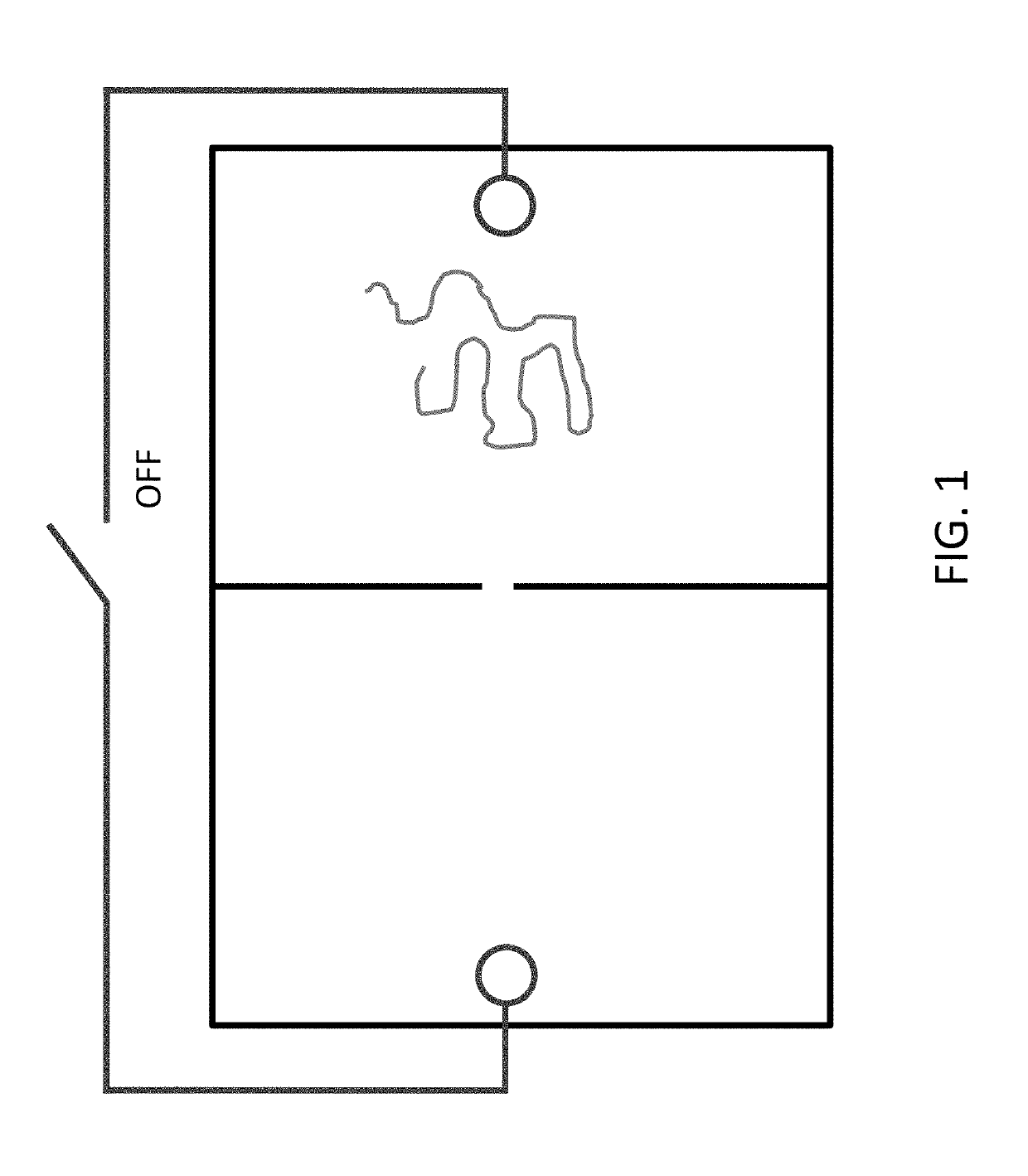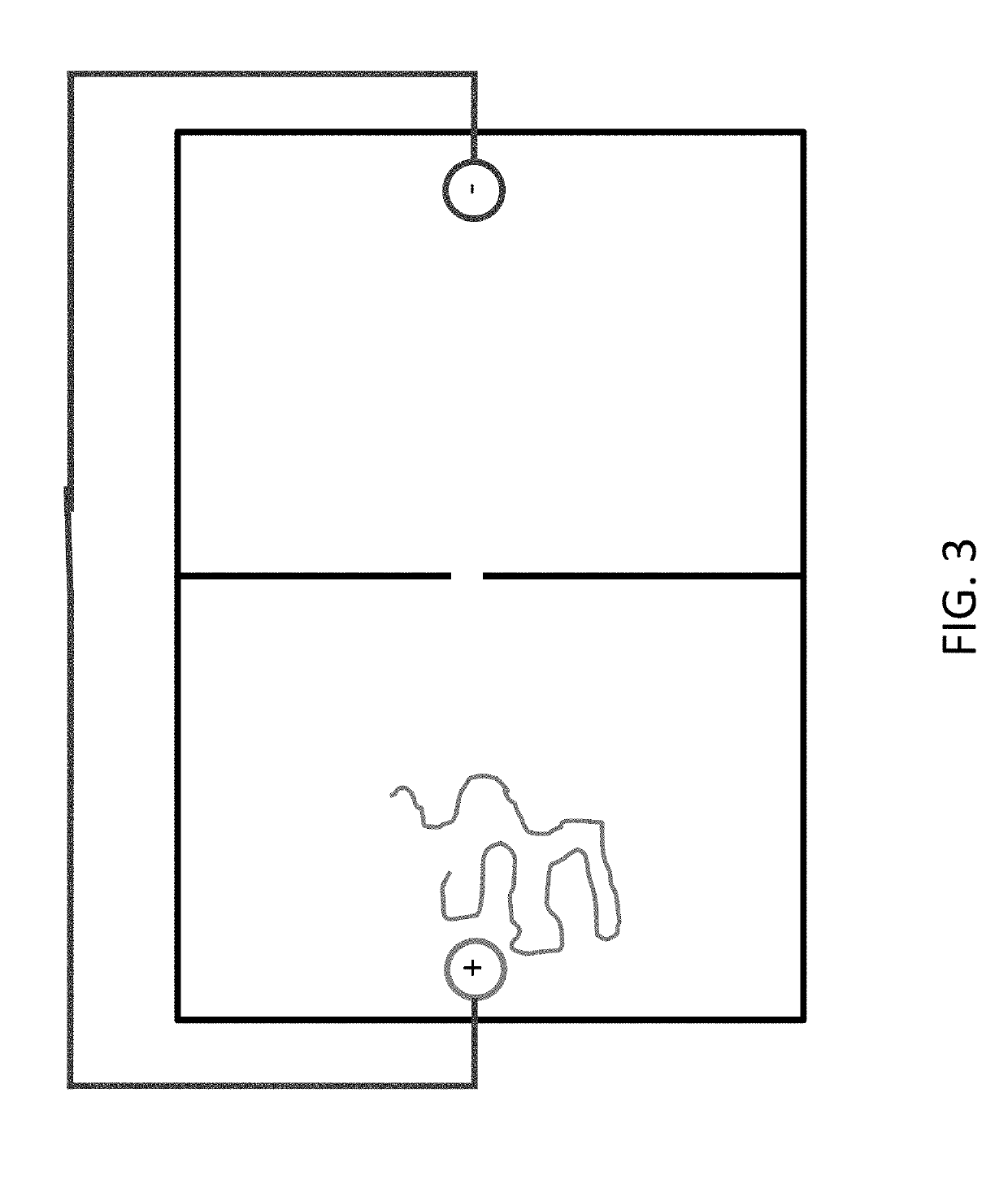Systems and methods for writing, reading, and controlling data stored in a polymer
a technology of data storage and polymer, applied in the field of systems and methods for writing, reading, and controlling data stored in a polymer, can solve the problems of no practical approach to implementing this idea, and large limitations of the approach, so as to achieve extremely rapid sequencing and read the sequence through a nanopore. , the effect of speeding up and improving accuracy
- Summary
- Abstract
- Description
- Claims
- Application Information
AI Technical Summary
Benefits of technology
Problems solved by technology
Method used
Image
Examples
example 1
ing One End of DNA Adjacent to Nanopore and Controlled Back and Forth Movement of DNA Via Electrical Current
[0622]Experimental procedures are developed to demonstrate that DNA is moved back and forth between two chambers separated by a nanopore, via an electrical current, under conditions that a relevant protein does not move between chambers.
[0623]A nanochip comprising two chambers is fabricated from silicon nitride. Nanopores of Automated fabrication of 2-nm solid-state nanopores for nucleic acid analysis, Small (2014)10(10):2077-86. The two chambers are referred to as a ‘near’ and ‘far’ chamber, the far chamber being the chamber where 3′ end of DNA is conjugated.
[0624]It is shown that ssDNA (2 nm pore) and ssDNA+dsDNA (4 nm pore) but not protein pass through the nanopore. Passing through the nanopores is detected by electrical current disruption.
[0625]Conjugation of DNA to Pore Surface:
[0626]Attach 5′ amino modified DNA to carboxy-coated polystyrene beads (Fluoresbrite® BB Carbox...
example 1a
ng DNA Strand Adjacent to Nanopore in a Silicon Dioxide Chip
[0635]A nanochip interior wall is fabricated from silicon dioxide. Both sides are silanized, but the oligonucleotide is conjugated to just one side of the chip wall, then a nanopore is created.
[0636]Silanization:
[0637]The surface of the chip wall is cleaned with piranha solution (various brands commercially available, generally comprising a mixture of sulfuric acid (H2SO4) and hydrogen peroxide (H2O2), which remove organic residues from the surface) at 30° C., and washed with double-distilled water. A stock solution of (3-aminopropyl)triethoxysilane (APTES) is prepared, with 50% methanol (MeOH), 47.5% APTES, 2.5% nanopure H2O, and aged >1 hour at 4° C. The APTES stock is then diluted 1:500 in MeOH and applied to and incubated with the chip wall at room temperature. The chip wall is then rinsed with MeOH and dried at 110° C. for 30 minutes.
[0638]Conjugation:
[0639]The chip wall is then incubated for 5 hours at room temperatur...
example 2
esis—Single Nucleotide Addition
[0641]DNA is moved to ‘reserve’ chamber by applying appropriate current and detecting DNA movement.
[0642]Terminal transferase enzyme (TdT, New England Biolabs) in appropriate buffer (50 mM Potassium Acetate, 20 mM Tris-acetate, 10 mM Magnesium Acetate, pH 7.9 @ 25° C.), plus reversibly blocked-dATP* is added to the ‘addition’ chamber. The buffer is also added to the ‘reserve’ chamber.
[0643]dNTPs that have reversible blocks on the 3′-OH are used to add nucleotides to the DNA. When added to the DNA chain, the next dNTP cannot be added until the blocked dNTP is unblocked.
[0644]Deblocking can be chemical or enzymatic. Different approaches are utilized:
[0645]a. 3′ 0-allyl: Allyl is removed by Pd-catalyzed deallylation in aqueous buffer solution as described in Ju J, Four-color DNA sequencing by synthesis using cleavable fluorescent nucleotide reversible terminators. Proc Natl Acad Sci USA. (2006);103(52):19635-40; or by using using iodine (10 mol %) in poly...
PUM
| Property | Measurement | Unit |
|---|---|---|
| probe frequency | aaaaa | aaaaa |
| frequency | aaaaa | aaaaa |
| current | aaaaa | aaaaa |
Abstract
Description
Claims
Application Information
 Login to View More
Login to View More - R&D
- Intellectual Property
- Life Sciences
- Materials
- Tech Scout
- Unparalleled Data Quality
- Higher Quality Content
- 60% Fewer Hallucinations
Browse by: Latest US Patents, China's latest patents, Technical Efficacy Thesaurus, Application Domain, Technology Topic, Popular Technical Reports.
© 2025 PatSnap. All rights reserved.Legal|Privacy policy|Modern Slavery Act Transparency Statement|Sitemap|About US| Contact US: help@patsnap.com



